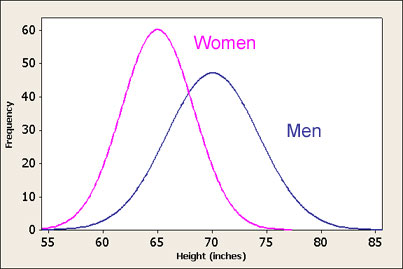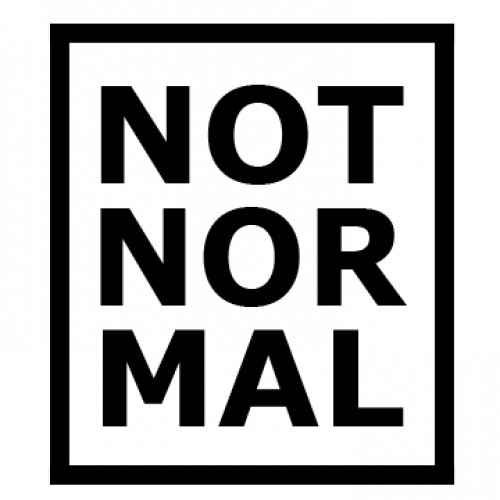Some people subscribe to the ‘better dead than average’ way of thinking. There is a normal tendency to want to be acknowledged, and to stand apart from the pack. People who expect a lot from themselves tend to think they are apart from the norm. But the truth (and this has been hard for me to accept!):
Most of us are normal. The average person truly is average. There’s nothing wrong with it. Whether it’s height, weight, strength, or IQ, most of us are in the center of the bell curve.

Mostly we’re in the middle! Being normal is, well, normal.
I’m not a genetic outlier — one of the people on the far right or left of the chart. You may not be one either. And that’s OK! Statistically, most humans don’t become professional athletes or win gold at the Olympics.
But that’s a bummer, right? Except it’s not. Being normal puts you in touch with the experiences of nearly every human being who ever lived. Being genetically normal is a huge opportunity to accept our common humanity, and give ourselves the same compassion we afford other human beings.
So what’s this got to do with strength, hypertrophy and getting fit?
After three decades of researching those topics, I’ve learned less than I’d like! But one thing I’ve learned is this: At some point in life, all of us need to throw a big dose of radical acceptance at how we approach strength, hypertrophy and fitness.
Even if you train hard, eat healthy, and get lots of sleep, there’s a solid chance you may not attain Captain America or Wonder Woman status. That’s no reason not to exercise, eat well, and get enough recovery, by the way!
If you train, eat and sleep an appropriate amount, you’ll be healthy and feel pretty super at times! Being near your own personal peak is a great feeling. Sure, gaining muscle and strength while losing fat is a sexy goal. But moving well, feeling good, being energetic, and preserving your health are greater indicators for your program’s long term success.
Radical acceptance aside, here’s Three Things I think I know about strength training:
- If you want to be strong, do resistance training of some kind (note: it doesn’t have to be traditional barbells). Loss of muscle and bone mass are two of the leading indicators for mortality. Weight bearing exercise can prevent both those things. Your body doesn’t know if it is lifting bags, bars, bells, or bodies. Work hard at what you choose.
- Per the above point, lots of tools can be used. Bodyweight training, kettlebell training, suspension trainers, sleds, barbells, sandbags, clubs, bands, chains and machines are all just tools in the toolbox of a smart trainee.
- Training is goal specific. Don’t use the wrong tool and try to make it the right tool. Bodyweight training won’t win you Power Lifting competitions, and PL training won’t make you better at planche pushups. It’s easy to get attached to a method, but no training system is dogma. They are all situational. Always try to increase the training stimulus in some way; progressive resistance is the classic example, but you can also increase volume, range of motion, improve on repetition records, or reduce rest time to make training harder.
Four Things I think I know hypertrophy training:
- Get stronger without getting injured. Increase weights while working in the 5-9 rep range. Go close to failure, sometimes. Keep a rep or so in reserve, sometimes. Increases in mechanical tension (or strength) tend to accompany increased muscular cross-section. Use mostly multi-joint, compound exercises that suit your physical structure. Cycle the intensity of your efforts once you get past the beginner stage.
- Get a pump too. Work in the 10-20 rep range. Use intensifying measures (drop sets, rest pause, supersets, etc). Go to failure or beyond, some of the time. Weight doesn’t matter as much here, but increase it if you can. Threatening the cell’s integrity from within with a full muscle pump causes the cell walls to thicken to protect itself (when given the chance to recover). Use a variety of exercises that allow you to get a full contraction.
- Put the muscles under a controlled stretch. Exercises like Romanian deadlift, incline curls, overhead tricep extensions and chest flies work well here. An external threat (the stretch) to the cell’s physical integrity is also a mechanism for growth (the cell super-recovers in order to protect itself from future stimuli like the stretch it just experienced).
- Eat a healthy diet, with lean meats, fruits, vegetables, unprocessed carbohydrates, and a mix of healthy fats at most meals. Note how much it takes for you to maintain (neither gaining, nor losing weight). Then add more real food to that diet to gain weight. Assess. Make changes according to your results. Supplement if necessary. Be objective.
Here’s Three Things I think I know about energy systems training:
- Most of the time, do base training that isn’t that hard. Do this almost daily, or daily. Keep your heart rate between 120 and 150 beats per minute. If you get close to 150, let it drop down to 120 before you continue. Or forget the heart rate, just breathe through your nose, and rest if you have to mouth breath. This doesn’t have to be done for a set time, but something over 15 minutes is good.
- On occasion, go harder or faster. Do this once a week. You should have full recoveries between attempts on this day. If your sport (or goal) places a big emphasis on going fast, you may have more of these days.
- Keep it simple. Push, drag, carry, and pedal. Sprinting is great, but remember running fast is a skill that not everyone has. Work within your ability level. Nearly everyone can push a sled. Not everyone is an effective sprinter.
As promised, Ten Things I think I know about getting hella strong, mega swole and annoyingly fit! The bonus is the point I started with — it’s OK to be normal. Life is still awesome! It might sound silly, but it was a real revelation for me.
If you’d like to work towards some real world fitness goals that will empower you in your life, and help you feel great, please get in touch with us at Iron Lion Training! Thanks for reading!
Ron Dykstra
Co-Owner Iron Lion Training Inc.
1485 Dupont, #312, Toronto, ON
Contact: info@ironliontraining.ca







